How To Choose the Perfect Spray Nozzle
In this blog post, learn key factors for selecting the right nozzle, impacting efficiency and cost savings. Discover how spray patterns, flow rates, and other features match different needs. The post also offers tips on maintenance and upgrades, highlighting a case where a simple nozzle change saved a company $10M. Ideal for anyone looking to optimize their spray processes, this guide emphasizes expert consultation for best results.

15
Jan 24
How To Choose the Perfect Spray Nozzle
Selecting the right spray nozzle for your application can be overwhelming with all the options available. Nozzles significantly impact the efficiency of your operations, the quality of your product, and your overall bottom line. By making minor adjustments to your equipment, you can achieve significant savings. One such example saw a snack food producer $10M by switching to a lower-capacity nozzle. To read more about this case, click here. This article will provide the basic knowledge you need when choosing a nozzle. We encourage you to contact your local spray expert for additional information.
What Factors Affect Your Nozzles Choice?
When selecting a spray nozzle, it's crucial to consider the following factors:
- Spray Pattern: The spray pattern of a nozzle determines the shape of the spray, which can be a flat fan, solid stream, full cone, or hollow cone. Each pattern is suitable for specific applications. For instance, flat spray nozzles are ideal for cleaning, rinsing, and coating, while full cone nozzles are great for washing, rinsing, and dust control.
- Flow Rate: The flow rate of a nozzle, measured in gallons per minute (gpm) or liters per minute (lpm), indicates the volume of liquid that the nozzle can spray in a minute. The right flow rate depends on your specific application requirements.
- Operating Pressure: The pressure at which a nozzle functions is known as the operating pressure and is measured in pounds per square inch (psi) or BAR. Higher spray pressure generally results in a higher flow rate for a given nozzle. Higher pressure can also generate greater impact and finer drop sizes. Use our flow rate calculator to easily determine your operating pressure.
- Material: The material of the nozzle should be chosen based on the type of liquid being sprayed and the operating conditions. Common materials include brass, stainless steel, and many plastic materials, including polypropylene, PVC, PTFE, and PVDF.
- Connection Type: The connection type of a nozzle, such as threaded, flanged, or quick-connect, should be compatible with your existing equipment.
- Drop Size: The size of the droplets produced by a nozzle is critical in determining the right nozzle for your application. Smaller droplets are ideal for humidification, cooling, or coating applications. They provide extensive surface coverage and rapid evaporation, essential in precise applications. Conversely, larger droplets are more suitable for high-impact applications like cleaning, heavy-duty rinsing, or direct product application.
Always consider the specific requirements of your application when choosing a spray nozzle. If you're unsure, consult with a spray technology expert.
Spray Pattern Basics
Understanding the different types of spray patterns is crucial when selecting the right nozzle. Here's a brief overview of the common spray patterns:
| Flat Spray | Flat spray nozzles produce a flat fan or sheet-type spray pattern, ideal for cleaning, rinsing, and coating. They offer spray angles ranging from 1° to 170° and flow rates from .003 to 1237 gpm. | 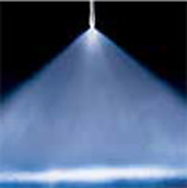 |
| Solid Stream | Solid stream nozzles produce a continuous, unbroken line of liquid. Common applications include cutting, cleaning, injecting, and targeted cooling. They operate at a spray angle of 0° | 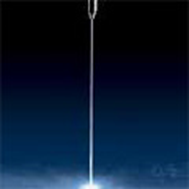 |
| Full Cone | Full cone nozzles produce a solid cone-shaped spray pattern with a circular impact pattern. They’re perfect for washing, rinsing, and dust control. They provide spray angles from 15° to 170° and flow rates from .05 to 8728 gpm. |
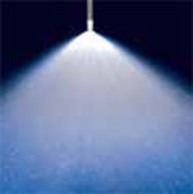 |
| Hollow Cone | Hollow cone nozzles produce a ring-shaped pattern suitable for cooling, washing, and dust control. They offer spray angles from 43° to 180° and flow rates from .05 to 3320 gpm. |
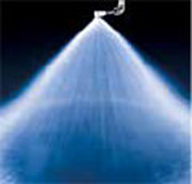 |
| Fine Spray | Fine spray nozzles are considered distinctly not because of a unique spray pattern but because of the small droplets they produce, which are ideal for humidifying, fogging, and dust control. They provide spray angles from 30° to 165° and flow rates from 49.2 to 8,160 gph. | 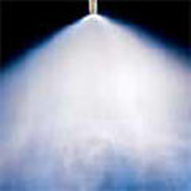 |
| Air Atomizing | Air atomizing nozzles produce very finely spray droplets, using compressed air for atomization rather than hydraulic pressure. They are used for coating, humidifying, and fogging and are available with a wide range of flow rates and spray patterns. | 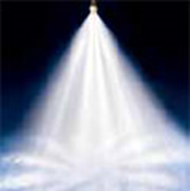 |
Pro Tip: Use the SprayFinder tool to find the right nozzle for your application quickly.
3 Key Steps to Optimize Your Nozzles
Improving your spray operations can lead to significant cost savings and increased production efficiency. Here are a few tips:
- Regular Maintenance: Regular spray nozzle maintenance is essential for ensuring optimal performance and extending the lifespan of your equipment. Over time, nozzles can experience wear, clogging, or buildup, leading to a list of issues. By routinely cleaning and inspecting your nozzles, you can ensure they operate at peak efficiency and deliver consistent spray patterns and flow rates. Staying on top of nozzle maintenance helps you limit downtime and achieve the desired results in your spraying operations.
- Optimize Spray Parameters: Optimizing spray parameters, such as liquid flow rate and pressure, is a pivotal step in ensuring the efficiency and effectiveness of your spraying operations. Doing so provides consistent spray patterns and waste reduction and improves your application's quality. For this, it's best to contact one of our spray experts who can give curated advice for your operations.
- Consider Upgrading Your Nozzles: Upgrading your industrial spray nozzles can be a game-changer in boosting operational efficiency and improving output quality. A few ways you can upgrade your nozzles are:
- • Material: The type of material used in your nozzle can help extend its wear life. Nozzles made from more resistant materials like hardened stainless steel, tungsten carbide, or ceramics are much stronger than aluminum, brass, or standard steel. A more resistant nozzle can help minimize costly downtime due to replacing it.
- • Quick-Connect Nozzles: Installing quick-connect nozzles, such as our QuickJet or Clip-Eyelet nozzles, can also help minimize downtime. Rather than replacing the whole nozzle, quick-connect nozzles allow you to replace the spray tip for easy cleaning and replacement. Want to learn more about quick-connect style nozzles? Click here to read our bulletin.
- • Automating Nozzles: Automated nozzles offer precision, efficiency, and adaptability in various applications. They are designed to adjust flow rates and patterns based on real-time feedback. This is typically achieved through sensors and control systems. Installing automated nozzles helps decrease waste, ensure consistent product quality, and improve operational safety.
Choosing the right spray nozzle isn't just a minor detail-it's central to how well your operations run. By getting a handle on the various spray patterns and aligning them with your specific needs, you can choose the right nozzle that optimizes your spray operations.
For more information or assistance in selecting the right spray nozzle, feel free to contact us. Our spray technology experts are always ready to help.

